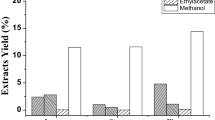Summary
This study examined anti-cancer compounds present in the chloroform extract of the Chinese medicine formula Shenqi San (CE-SS). Silica gel column chromatography, Sephadex LH-20, octadecylsilyl (ODS) column chromatography, and high performance liquid chromatography (HPLC) were used to separate the compounds from CE-SS. The structural formulas of the separated compounds were determined using 1D 1H and 13C experiments as well as high resolution electrospray ionization mass spectroscopy (HRESIMS). The corresponding results were compared with the reported literature data. A total of six compounds were separated and their structures were identified on the basis of corresponding spectroscopic and physico-chemical properties. They were Saikogenin F (I), Prosaikogenin D (II), Prosaikogenin F (III), β-sitosterol (IV), 3β,16β,23-trihydroxy-13,28-epoxyurs-11-ene-3-O-β-D-glucopyranoside (V), and methyl ursolic acid (VI). The separated compounds were evaluated in vitro for their inhibitory ability against the proliferation of A549 cells via MTT assay. Apoptosis was investigated using Annexin V-FITC/propidium iodide (PI) by flow cytometry. Apoptosis-associated proteins were examined by Western blotting. All the compounds were observed to have inhibitory activities against the proliferation of A549 cells to different degrees. Flow cytometry showed that compound V increased the proportion of apoptotic A549 cells in a dose-dependent manner. Western blotting showed that compound V increased the expression of Bax, cleaved-caspase-3, cleaved-caspase-9 and cleaved-poly ADP-ribose polymerase (PARP), and decreased the expression of Bcl-2. These results indicated that compound V featured a significant inhibitory effect on A549 cells when compared with other compounds, and it may be considered a potential drug against cancers.
Similar content being viewed by others
References
Chen W, Zheng R, Baade PD, et al. Cancer statistics in China, 2015. CA Cancer J Clin, 2016,66(2):115–132
Siegel RL, Miller KD, Jemal A. Cancer statistics, 2018. CA Cancer J Clin, 2018,68(1):7–30
Chen Z, Fillmore CM, Hammerman PS, et al. Non-small-cell lung cancers: a heterogeneous set of diseases. Nat Rev Cancer, 2014,14(8):535–546
Shi L, Ai ZZ, Zhang DZ, et al. Anti-Tumor and Analgesic Effects of Shenqi powder. Med J Wuhan Univ (Chinese), 2016,37(3):411–413
Xia Y, Shi L, Ai ZZ, et al. Chinese medicine formula “Shenqi San” extract inhibits proliferation of human lung adenocarcinoma A549 cells via inducing apoptosis. J Huazhong Univ Sci Technolog Med Sci, 2017,37(5):766–771
Hou JQ, Guo C, Zhao JJ, et al. Anti-inflammatory Meroterpenoids from Baeckea frutescens. J Nat Prod, 2017,80(8):2204–2214
Zhu ZJ, Pan RL, Si JY. Study on the Chemical constituents of Bupleurum bicaule. Nat Prod Res Dev, 2008,20:833–835
Mencherini T, Picerno P, Scesa C, et al. Triterpene, antioxidant, and antimicrobial compounds from Melissa officinalis. J Nat Prod, 2007,70(12):1889–1894
Ye L, Qian J, Jin S, et al. Algicidal effects of four Chinese herb extracts on bloom-forming Microcystis aeruginosa and Chlorella pyrenoidosa. Environ Technol, 2014,35(9–12):1150–1156
Moreira H, Slezak A, Szyjka A, et al. Antioxidant and Cancer Chemopreventive Activities of Cistus and Pomegranate Polyphenols. Acta Pol Pharm, 2017,74(2):688–698
Possebon L, Lebron IDL, da Silva LF, et al. Anti-inflammatory actions of herbal medicines in a model of chronic obstructive pulmonary disease induced by cigarette smoke. Biomed Pharmacother, 2018,99(2018):591–597
Xia Y, Yu B, Ma C, et al. Yu Gan Long reduces rat liver fibrosis by blocking TGF-beta1/Smad pathway and modulating the immunity. Biomed Pharmacother, 2018,106:1332–1338
You P, Fu S, Yu K, et al. Scutellarin suppresses neuroinflammation via the inhibition of the AKT/NF-kappaB and p38/JNK pathway in LPS-induced BV-2 microglial cells. Naunyn Schmiedebergs Arch Pharmacol, 2018,391(7):743–751
Mohammad RM, Muqbil I, Lowe L, et al. Broad targeting of resistance to apoptosis in cancer. Semin Cancer Biol, 2015,35:S78–S103
Wang J, Li JZ, Lu AX, et al. Anticancer effect of salidroside on A549 lung cancer cells through inhibition of oxidative stress and phospho-p38 expression. Oncol Lett, 2014,7(4):1159–1164
Wang X, Wang D, Zhao Y. Effect and Mechanism of Resveratrol on the Apoptosis of Lung Adenocarcinoma Cell Line A549. Cell Biochem Biophys, 2015,73(2):527–531
Ye MX, Zhang J, Zhang J, et al. Curcumin promotes apoptosis by activating the p53-miR-192-5p/215-XIAP pathway in non-small cell lung cancer. Cancer Lett, 2015,357(1):196–205
Pham TA, Shair Mohammad I, Vu VT, et al. Phloroglucinol Derivatives from the Fruits of Eucalyptus globulus and Their Cytotoxic Activities. Chem Biodivers, 2018,15(6):e1800052
Zhou S, Wang Y, Zhu JJ. Simultaneous Detection of Tumor Cell Apoptosis Regulators Bcl-2 and Bax through a Dual-Signal-Marked Electrochemical Immunosensor. ACS Appl Mater Interfaces, 2016,8(12):7674–7682
Czabotar PE, Lessene G, Strasser A, et al. Control of apoptosis by the BCL-2 protein family: implications for physiology and therapy. Nat Rev Mol Cell Biol, 2014,15(1):49–63
Golestani Eimani B, Sanati MH, Houshmand M, et al. Expression and prognostic significance of bcl-2 and bax in the progression and clinical outcome of transitional bladder cell carcinoma. Cell J, 2014,15(4):356–363
White MJ, McArthur K, Metcalf D, et al. Apoptotic caspases suppress mtDNA-induced STING-mediated type I IFN production. Cell, 2014,159(7):1549–1562
Shalini S, Dorstyn L, Dawar S, et al. Old, new and emerging functions of caspases. Cell Death Differ, 2015,22(4):526–539
Youle RJ, Strasser A. The BCL-2 protein family: opposing activities that mediate cell death. Nat Rev Mol Cell Biol, 2008,9(1):47–59
Lee DH, Kim DW, Jung CH, et al. Gingerol sensitizes TRAIL-induced apoptotic cell death of glioblastoma cells. Toxicol Appl Pharmacol, 2014,279(3):253–265
Zhang F, Shi JJ, Thakur K, et al. Anti-Cancerous Potential of Polysaccharide Fractions Extracted from Peony Seed Dreg on Various Human Cancer Cell Lines Via Cell Cycle Arrest and Apoptosis. Front Pharmacol, 2017,8:102
Author information
Authors and Affiliations
Corresponding authors
Additional information
Conflict of Interest Statement
The authors declare that they have no conflict of interest.
This work was supported by the Natural Science Foundation of Hubei Province of China (No. 2018CFB657), the China Postdoctoral Science Foundation (No. 2016M592320) and the Doctoral Scientific Research Foundation of Jianghan University (No. 08250001).
Rights and permissions
About this article
Cite this article
Shi, L., Tu, Yj., Ye, Sq. et al. A Potential Anti-cancer Compound Separated from the Chloroform Extract of the Chinese Medicine Formula Shenqi San. CURR MED SCI 40, 138–144 (2020). https://doi.org/10.1007/s11596-020-2157-5
Received:
Revised:
Published:
Issue Date:
DOI: https://doi.org/10.1007/s11596-020-2157-5




